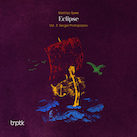

Mattias Spee: Eclipse, Vol. 3: Sergei Protopopov
TRPTK
Having focused in the Eclipse series' first volumes on the music of Joseph Wölfl and Hans Henkemans, Dutch pianist Mattias Spee concludes his trilogy with a set featuring material by Soviet composer Sergei Protopopov. Like the others, Protopopov is an obscure figure whose name and music are unfamiliar to most, and with the series Spee has done what he can to shed a light on this neglected if not forgotten artist. On the seventy-three-minute release, he's as much music historian as performer, given the in-depth liner notes he wrote for the booklet that provide details about Protopopov's life and artistic approach.
While his music primarily bears his signature, it sits comfortably alongside that created by other composers living through the tumultuous times of the Soviet era; it wouldn't be inaccurate either to hear Protopopov's music as sharing certain tonal and stylistic properties with Scriabin's. Considered a part of the Soviet musical avant-garde, Protopopov was born in Moscow in 1893 and died there sixty-one years later. A 1913 meeting with pianist and musicologist Boleslav Yavorsky would prove propitious: not only did Protopopov begin taking private lessons with him, the two would later work together professionally when the young pianist, having graduated from the Kiev Conservatory, took a teaching position at the Yavorsky-founded Music Technicum; as critically, their relationship eventually became a romantic one.
A 1908 book by Yavorsky, its English title Structure of Musical Speech, exerted a powerful influence on Protopopov in outlining a theory of modal rhythm. In Spee's words, it “poses that the tritone is an inherently unstable interval, which always wants to resolve inwards and that this inward motion is the driving force in almost all music.” As the author was not a composer, it was Protopopov who put the theory into practice and led to him becoming a pioneering force in symmetrical harmony. Such innovations were, of course, frowned upon the Soviet regime and by the early ‘30s Protopopov had been boycotted, ostensibly for creating complex art incompatible with official Soviet doctrine. In crafting work expressing grief and pain—and by extension how painful life could be for workers in the Soviet Union—he was regarded by government officials as an enemy of the regime. The final nail in the coffin, so to speak, was the book Protopopov published in 1931, Elements of the Structure of Musical Speech, which expanded on Yavorsky's earlier work by extending its ideas to microtonality. When the book was officially declared anti-Marxist, Protopopov's career was all but over. Three years later, he was sentenced to three years of imprisonment for “engaging in homosexual activity”; that he but not Yavorsky was arrested suggests, however, that it was really the authorities' way of silencing him as an artist. Following his release in 1938, he gained a position as a music theory teacher at the Moscow Conservatory and resumed composing, but his best years creatively were behind him. His life-long love Yavorsky passed away in 1942 and Protopopov died a quiet and anonymous death twelve years later.
On the release, a quartet of Protopopov works is presented, three of them sonatas and the fourth a concise setting originally written for violin, cello, and piano. Spee, a composer too, intersperses three intermezzi of his own that enrich the overall programme and complement the other pieces (the spectral realms they conjure recall Berg as much as Protopopov). The sonatas are a fascinating trio for many reasons, but one is structural: composed in 1922, Op. 1 adheres to a traditional three-movement design; written two years later, Op. 5 is a single-movement work lasting sixteen minutes; and Op. 6, completed in 1928, is also in one movement but extends across thirty-three minutes. The influence of late-romantic Russian composers and particularly Scriabin emerges in the Op. 1 sonata; an aura of nocturnal mystery pervades the “Rapido con attività” movement, even if upper register patterns do dance floridly across the oppressive undercurrents unfolding below. The peaceful “Lento” that follows is less dark by comparison and a splendid illustration of Spee's delicate touch. Energy reinstates itself for the concluding “Lugubre tempestoso,” though here too a few moments of sensitive restraint offset the swelling oceanic expressions.
For the Op. 5 sonata, Protopopov deployed a three-note motif as the cell upon which the thematic material builds. In elaborating upon the motif by presenting it at different speeds and dynamics, an intricate and immersive sound world of panoramic scope is created; the feeling created is of an organism evolving patiently through time, its shape mutating as it expands and contracts. Two-thirds of the way through, the music plunges into a deep well of despair before pulling itself out during the final minutes. It's well nigh impossible to hear the towering Op. 6 sonata as anything but a dazzling odyssey. That Spee is able to sustain his energy and concentration at such a high level for its half-hour-plus duration is impressive. As the piece progresses, one might be inclined to concur with the pianist's characterization of it as “an unrelenting bombardment of sound” that could not have been written without Protopopov having been “haunted by some kind of mania.” With ample time at its disposal, the material undertakes its climb slowly, advancing patiently and fluidly through multiple episodes, some hushed and pensive, others declamatory, until it reaches an all-consuming climax. Acting as something of a postlude, Sun-Kissed Clouds concludes the set with a lyrical, even dream-like expression to ease the listener out of the release gently.
Spee's been described as having a “velvet touch,” and certainly there's ample evidence on hand to support it, and Protopopov is fortunate to have him as his spokesperson when the pianist's playing is articulate, eloquent, and wholly sympathetic to the composer's vision and sensibility.April 2025